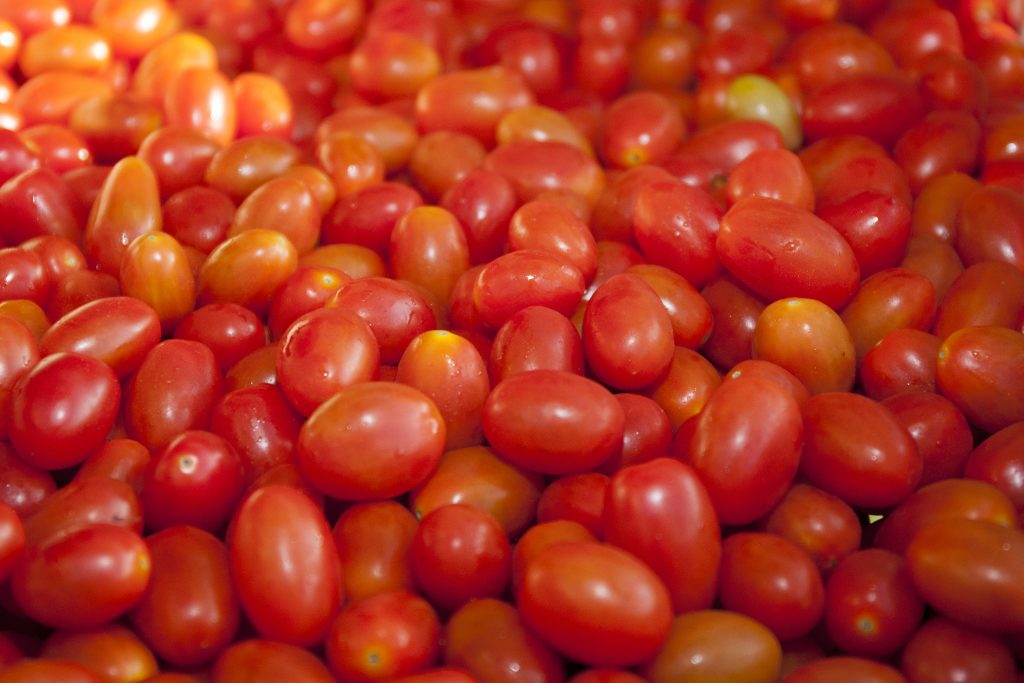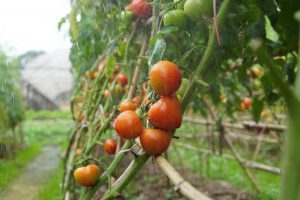Tomatoes rank high among the favorites for home gardeners, cherished for their versatility and flavor. Whether planted in traditional garden beds, confined to containers, nurtured in hydroponic setups, or suspended in hanging baskets, tomatoes thrive in the Florida Panhandle given the right care and understanding of essential growing principles. With a bit of advice and a dash of perseverance, achieving a beautiful harvest of delicious tomatoes is not only fun but also fulfilling. Check out these tips for successfully growing tomatoes in your home garden.

PERFECT TIMING
In the Panhandle, we’re fortunate because we can start planting tomatoes earlier than many other places. But because tomatoes thrive in warm weather, it’s important to wait until the risk of frost is gone before putting them outside. If you’re eager to begin, you can start growing tomato seedlings indoors. Once the weather warms up, you can move these seedlings outside. Another option is to plant tomatoes in lightweight containers. This makes it easy to protect them if there’s a late frost or freeze by moving them to a safer spot. However, don’t delay planting your tomatoes for too long! They need time to grow and produce fruit before the summer heat sets in. Once nighttime temperatures stay above about 80 degrees consistently, larger tomatoes might stop growing fruit. But smaller types like cherry and grape tomatoes usually do just fine.
DETERMINATE OR INDETERMINATE
Some tomatoes, called determinate or “bush” types, grow to a specific size and don’t need pruning. Their fruits all ripen together within 1-3 weeks, which is great for container gardening and canning. Then there are indeterminate or “vine” tomatoes, which keep growing and producing fruit all season long. These kinds need support like stakes and some pruning to keep them neat and tidy in the garden.
RIGHT PLANT, RIGHT PLACE
Tomatoes are sun-lovers, needing about four to six hours of sunlight every day. So, when planting them, choose a sunny spot in your yard. Before planting, consider getting your soil tested by your local Extension office. You’re aiming for a soil pH between 6.2 to 6.5, which is ideal for tomatoes. Also, enrich your soil with organic materials like composted manure. When planting your tomatoes, it’s helpful to bury them slightly deeper than they were in their original pots. This encourages better root growth.
TOP TOMATO VARIETIES FOR THRIVING IN NORTH FLORIDA’S CLIMATE
Florida’s warm and sometimes damp weather can cause problems with insects and diseases that harm tomatoes. To avoid these issues, it’s smart to pick tomato types that can resist common diseases such as verticillium wilt and fusarium wilt, as well as pests like nematodes. Check the seed package for information about resistance. For this region, some good choices are the ‘Better Boy’ and ‘Celebrity’ varieties. If you prefer heirloom tomatoes, think about trying ‘Cherokee Purple’ and ‘Green Zebra’.

Photo credit Anh Ngo Hoang (Pixabay)
PROVIDE SUPPORT
For tomatoes that keep growing, like indeterminate ones, people often use wire cages, stakes, or trellis systems to support them. It’s a good idea to put these supports in place either right before planting or shortly after, so you don’t mess up the plant’s roots. As the tomato plants get bigger, you can use clips or ties to attach them to the support. Another way is to put stakes between each plant in a row and weave string through them to help support the plants as they grow taller.
EARLY AND THOROUGH SCOUTING
To stop small problems before they get big, make sure to inspect your plants often for signs of bugs or diseases. If you want to learn more about dealing with these issues, you can check out the Tomato Insect Pest Management guide on Gardening Solutions website: https://gardeningsolutions.ifas.ufl.edu/care/pests-and-diseases/pests/management/tomato-insect-pest-management.html.
FEEDING THE PLANT & TAILORING FERTILIZATION
Just like people need food to grow, tomatoes also need specific nutrients to thrive. Using a fertilizer with a ratio like 6-8-8 or something similar will provide these essential nutrients for your plants. You can choose between a liquid fertilizer mix or granular fertilizer. It’s important to fertilize when you plant your tomatoes and continue to do so regularly during the growing season to keep them healthy and strong.
DROPLETS OF SUCCESS
Pick a location for your garden that’s near a water source, like a hose or watering can. Drip irrigation is a good choice because it gives the right amount of water and helps keep leaves dry to prevent diseases. Make sure watering your plants is convenient for you. Aim to water your garden with about 1-2 inches of water each week to keep your tomatoes healthy.

Successfully growing tomatoes requires attention to detail and consistent care. Ultimately, providing your tomatoes with the proper care such as adequate water, sunlight, and nutrients, is essential for their health and productivity. With these practices in mind, you can look forward to a harvest of delicious tomatoes from your Panhandle garden. For more information about growing tomatoes in the Florida Panhandle, contact your local County Extension Office.
- The Third Place - April 11, 2024
- Tomato Tips: Keys to Success - February 29, 2024
- Camellia -The Rose of Winter - January 25, 2024
